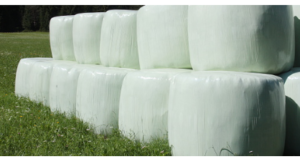Silage wrap is a specialised plastic film used in agriculture to preserve forage such as hay and straw. It provides a protective barrier that keeps spoilage microorganisms out and air in, keeping forage fresher longer.
 The best bale wrap will have high UV protection, tack (stickiness), and tear resistance. Learn more about each of these attributes in our stretch wrap guide and this cast vs. blown film article.
The best bale wrap will have high UV protection, tack (stickiness), and tear resistance. Learn more about each of these attributes in our stretch wrap guide and this cast vs. blown film article.
Strength
UV-resistant silage wrap is an agricultural film that protects and preserves forage such as hay, straw or maise in a silo, bunker or by wrapping bales for outdoor storage. The airtight barrier it creates helps maintain the nutritional value of the forage by preventing spoilage due to weather or pests. Choosing a high-quality silage wrap that is strong enough to resist damage during the wrapping process and throughout the storage period is important.
The thickness and strength of a silage film is also an important factor to consider. Thicker films are often stronger and more puncture-resistant, while thinner films may be less durable and more susceptible to damage during installation and storage.
Durability
A high-quality UV-resistant silage wrap can help preserve the nutrient content of crops, ensuring that they can be used for animal feed later. Additionally, it reduces heat buildup in the crop, which can cause damage. The wrap also protects the product from pests and other external elements.
The durability of a silage film is determined by its thickness and puncture resistance. Generally, thicker films are more durable than thinner ones. However, it is important to note that a higher tensile strength can also affect the durability of a film.
A quality silage wrap is also highly abrasion and tear-resistant. It ensures it can withstand repeated handling and stacking without damage or tearing. In addition, the wrap’s low permeability helps prevent oxygen ingress and accelerates the fermentation process.
It is important to note that the wrapping process must be completed within 24 hours of baling. Otherwise, the bales will start to ferment and may burst. Therefore, wrapping the bales close to where they will be stored is recommended to reduce handling and transportation.
Tackiness
Silage wrap is an air and UV-resistant barrier to preserve crops and extend nutrient life. In addition to preventing mould formation, it protects the crop from moisture and other external elements, enabling farmers to harvest their crops later. It is crucial to prevent the loss of valuable nutrients from spoilage, resulting in reduced dietary intake for livestock.
To make the most of your bale wrap, it’s important to choose a film that has a high cling level and good tear resistance. It will ensure that the film sticks firmly to the surface of the bale, creating an airtight seal and protecting the forage from mould and weather damage. It’s also important to consider the durability of the UV-resistant silage wrap, as it must withstand the rigours of handling and storage, including potential contact with equipment or sharp edges.
Tear Resistance
A strong and durable silage wrap helps to protect your hay or straw bales, keeping them from spoilage and preserving their nutritional value. Consider using a high-quality multi-layer co-ex hay silage plastic film to ensure you get the best possible performance. Designed to be hardwearing, this type of bale wrap is also airtight and offers long-term storage in an oxygen-detested environment. Sunfilm, RaniWrap and SILOPAK are all top-selling manufacturers of this type of stretch film.
When selecting a quality silage wrap, ensure you have the correct dimensions for your bales and overlap the layers by 50% to create an effective barrier against oxygen ingress. It would be best to store the wrapped bales or piles in a suitable area, away from moisture and direct sunlight, which can accelerate spoilage.
Tear resistance is another key aspect of a good silage wrap, as it determines how well the film holds up during use and over time. This feature can be improved through high-quality materials, appropriate manufacturing techniques and adequate UV protection. It can also be impacted by how the film is handled and stored, as damage to the material can compromise its durability.
